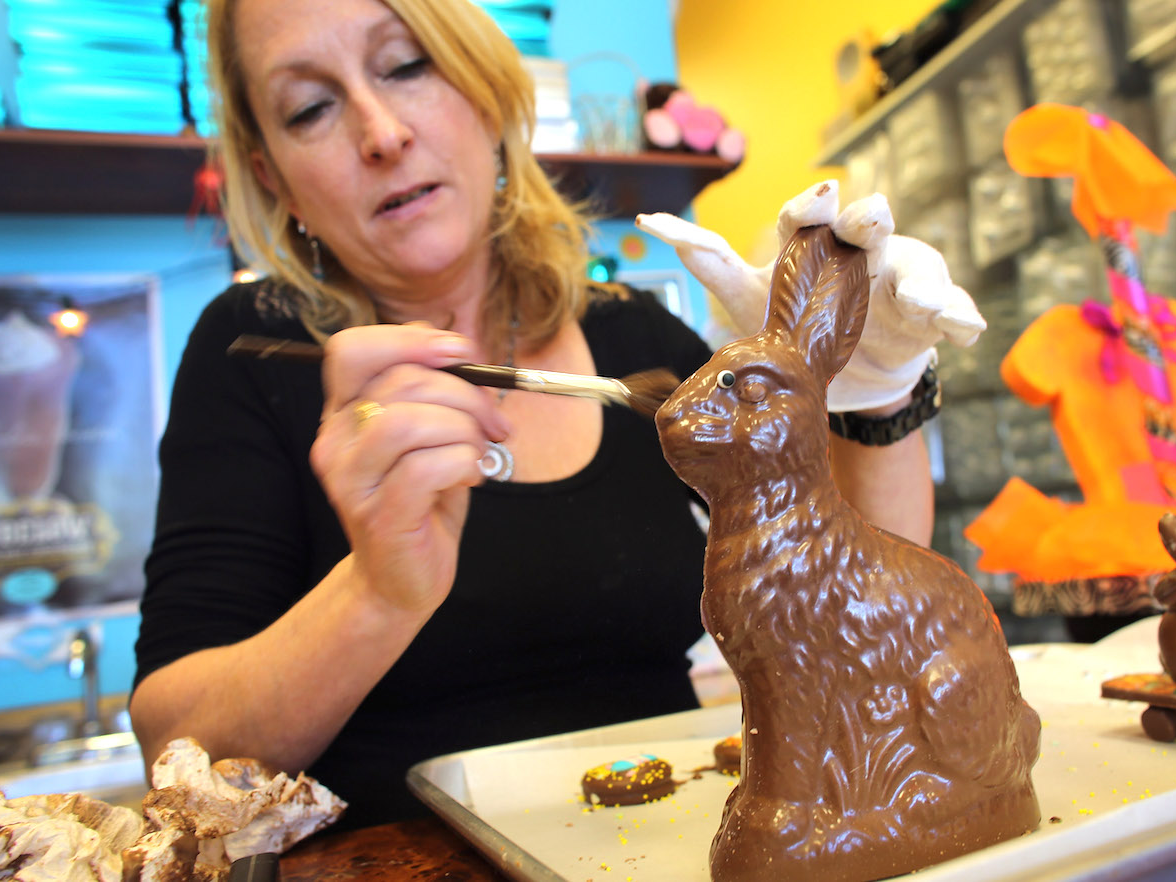• Easter in the United States is widely associated with bunnies, candy, and flowers.
• Many of those symbols have ancient origins.
• But the idea that Easter’s name derives from a pagan goddess is likely untrue.
Easter is the most important feast day on the Christian calendar: a celebration centered around Jesus Christ rising from the dead.
So, what do egg-hiding, floppy-eared bunnies, chocolate encased in colorful plastic shells, and pretty flowers have to do with any of that?
Such symbols are sometimes written off as a sort of pagan residue, left over from before Christianity swept across Europe.
But that's probably not true - or, at least, not entirely true.
Eostre is frequently cited as a pre-Christian Germanic spring goddess (who hung out with a rabbit, no less). Early Christians are said to have co-opted her festival's symbols and rituals - and even her name! But the only documentary evidence for this goddess exists in early medieval monk and scholar Bede the Venerable's telling.
The evidence for Eostre-worship being the basis of Easter traditions is thin, at best, as the Guardian's Adrian Bott previously asserted. It's not that it's impossible that Eostre was indeed a popular pagan goddess, or that such pre-Christian influences survive today - it's just that there's really not much concrete to base that assertion on.
Historians in the 19th and 20th century often argued that most medieval Christians were actually just thinly veiled pagans. However, that trend has changed in recent years. As English historian Ronald Hutton put it in his article "How Pagan Were Medieval English Peasants?": "... there is no good evidence for a survival of active paganism among the English population after the early eleventh century."
That doesn't mean that there aren't some strange and unusual beginnings for some of Easter's most popular symbols, however.
Here are some popular Easter symbols with surprising origins:
Bunnies are ancient symbols of fertility

Medieval folks couldn't get enough of bunnies. They're a frequent theme in illuminated manuscripts and other art from the Middle Ages.
Ancient scholars like Pliny the Elder and Artistotle wrote about hares and their propensity for fertility (as the Smithsonian reported, Aristotle actually was right when he proposed that rabbits can get pregnant while they're pregnant).
Due to this potential for double pregnancies, as English polymath Sir Thomas Browne wrote, hares were also long believed to be hermaphroditic - and, therefore, capable of virgin births. That led to an association with the Virgin Mary. The sign of the three hares appears in medieval Christian art as well, symbolizing the Trinity.
So it's not surprising that the hare became especially associated with Easter in Germany by the 17th century. As History.com reported, it was likely German immigrants who brought the idea of the Easter bunny to America in the 1700s.
Eggs have represented new life for centuries... for obvious reasons

Every Easter, children embark on hunts for candy and chocolate enclosed in colorful plastic eggs. It's a bit like the tradition of waking up to presents on Christmas morning, except with more sugar and running around.
The history of egg symbolism goes back centuries. As Forbes reported, "In pagan times, eggs were part of the Bacchic or Dinoysian mysteries, possibly a symbol of the underworld; they could be used to cast spells and, conversely, to offer protection."
Later on, eggs became a symbol of rebirth for Christians.
Easter eggs first got a shout out in a book aptly titled "De ovis paschalibus" (or, "About Easter eggs"). As the book "Thinking Like an Anthropologist" says, the 1682 book refers to "... an Alsace tradition of an Easter Hare bringing Easter Eggs."
Lilies received a special shout-out in the Bible

In the spring, we're all happy to see any flowers at all, but one flower in particular has come to represent the holiday: the lily.
Lilies come up a few times in the Bible. Jesus even mentions the flower in the Gospel of Luke, 12:27, saying: "Consider the lilies how they grow: they toil not, they spin not; and yet I say unto you, that Solomon in all his glory was not arrayed like one of these."
Lilies also turn up in the story of Easter. In some legends, they are said to have bloomed in the Garden of Gethsemane after Christ's agony. As a result, it's become the flower traditionally associated with the feast.
Even digging into candy on Easter is tied to history

So, why do we stuff ourselves with candy on Easter?
Well, as the medieval blog "A Medievalist Errant" points out, Easter takes place at the end of Lent, a 40-day period of fasting and contemplation for Christians.
Fasting was a bit more intense in the medieval world. Meat and animal products (including eggs and dairy) would have been off-limits for all of Lent for most people. Once Easter hit, people would celebrate with a feast, which might even take place at the home of the local lord.
So, while the eating yourself into a Peeps-induced coma on Easter is certainly a modern concept, the idea of indulging once Lent ends dates back quite a while.


